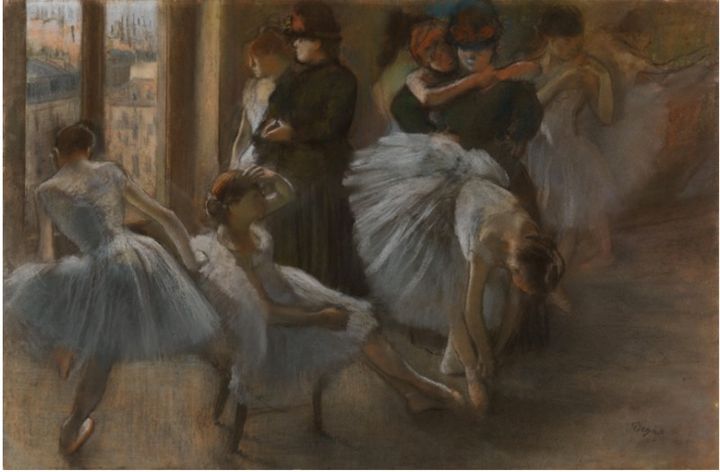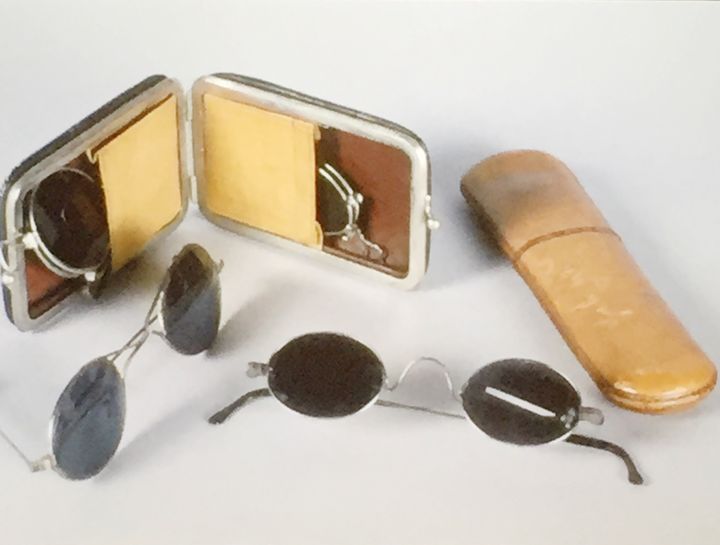
Preparation for the Class by Degas 1877
Last week I attended a very excellent centenary tribute to Edgar Degas at the National Gallery of Art. The program was free, and I felt strong enough to head over. A former ballet dancer myself, Degas has long been my favorite impressionist painter because of his numerous paintings of ballerinas. And his most famous sculpture is right here in DC – The Little Dancer Aged Fourteen. Whenever I’m at the National Gallery, I’ll stop by to see her on the lower floor sculpture galleries.

Degas' Glasses
To my surprise, I learned that Degas had a serious disability. Maybe I knew of this in college and forgot; his disability certainly had new resonance for me now as I’ve struggled with disability for seventeen years. He had retinal disease, probably macular degeneration, for nearly half his life. His eyesight was so poor than when he died, his friend and fellow painter Pierre Auguste Renoir said, “It is fortunate for him … any conceivable death is better than living the way he was.”
I know sometimes I feel that way about my own disability. But in listening to various curators, art historians, conservators, researchers and academics, I learned a lot about Degas and his life and work.
In honor of the 100th anniversary of his death which was on September 27, 1917, here are 9 uplifting and encouraging lessons that are still relevant from the example of Degas ::
1 / See Afresh
Degas was a self-conscious viewer because of his poor eyesight. The condition pushed him to see the world afresh, to see light and dark contrasts, and to see life and figures anew. And he reflected this acute vision through his art.
Any disability makes us reflect and see our lives differently. Yes, the disability is a curse; we’d rather be able. But the special seeing can be a blessing whether you’re a painter or not. You see and appreciate the worthy better. The contrast between good and bad is sharper. And we are better viewers, and we see afresh.
2 / Experiment
Degas loved exploring the unknown. He was an avid consumer of the latest science. And the late 19th century was a time of terrific scientific advancement – Darwin developed his theory of evolution, Pasteur created vaccines and the process to kill bacteria that caused spoilage, and Rozier and d’Arlandes flew their first hot air balloon giving us our first view down onto the earth. And the Paris Exposition of 1878 featured the new power of electric light, solidifying the city’s reputation as the city of lights (originally earned because of the installation of 56,000 gas lights on the streets in the 1860s).
Many of the artists at the time retreated into scenes and compositions of nature such as trees, skies and waterways. But Degas, born in Paris to a moderately wealthy family, embraced urban life and science. Degas had the heart of scientist and loved experimenting.
Those of us who are disabled and those afflicted with sickness are acutely familiar with facing the unknown. Our bodies’ unpredictable nature forces us to take it step by step as we go forward. Degas did so fearlessly and enthusiastically – embracing science and experimentation. He would start a piece without knowing how it would come out. We start every day without knowing how it will finish. We too should be unafraid to experiment because our outcomes are unknown anyway. We might as well. We might yield a better result and find an innovation that helps.
3 / Be Pragmatic
Degas used tracing paper. That surprised me, but in the slides the art historian showed, you could clearly see the mirrored figures. They were exactly alike but reversed. And he did that using tracing paper. He even experimented with using photography which was very new at the time, and indeed some of his drawings resemble a candid, uncalculating snapshot.
Tracing paper and photography might be controversial and considered “cheating” for an accomplished artist. And yet, he used these useful tools.
Likewise, don’t doubt your abilities. You’re weak because of your illness. You’re not being lazy. You’re can’t think clearly because of the brain fog. So be pragmatic and “cheat” with impunity with whatever tools help you. Harness whatever tools you need and invent some if need be. Degas invented his own glue. He even reinvented the tools he had – using pastels to mimic the effect of painting. Be creative until you find something that works.
4 / Circle Back
Degas worked on some paintings over decades. He reworked one painting, Scene from a Steeplechase, in 1866, in 1880-81 and again in 1897. His concept of done was elastic. There’s a famous story about Degas, upon seeing one of his own earlier works at the home of Henri Rouart, harassing Rouart to let him take it back. Degas wanted to take it back to his easel and re-work it. Rouart finally gave in, and the work was never seen again. Degas confessed he had over-worked it and gave Rouart another painting, the famous ‘Danseuses a la barre’.

Danseuses à la barre by Degas c. 1900
So too our lives can always be re-worked. Until we are dead, we can always circle back. When you are ill, the areas of your life that need work become magnified. We realize and see that perhaps we need to eat better or sleep more or clean up our relationships. Our life cycles are more pronounced. Circling back is not a failure; everything circles back around even the planets and the starts. The ability to reexamine and rework our lives displays a willingness to evolve and a desire to living well.
5 / Scrape & Dig Away Excess
Degas’ work in pastels embody the best examples of his willingness to layer and scrape. Pastels are powdered pigments molded into sticks. Degas made his own. When laid onto paper the pigment is opaque. In order to reveal a sense of nuance and depth to his work, he would layer the colors and then scrape them away to reveal the colors underneath. The subtraction of color created the beauty.
My life often feels monotonous and monotone. We’re inclined to feel that’s because of so much of what we had in our life is now absent. We think only of addition and of our inability to actively add – activities, friends, events. But what if subtraction could add richness, depth and nuance to our lives? Perhaps we can find that by excising elements of our lives, we enhance what is already there. When you get sick, you have no choice. You have to safeguard your health and excise those who don’t love you. You have to eliminate obligations that tire you. You have to stop doing things that harm you. Then what’s left is beautiful.
6 / Use Support Where Needed
Degas sometimes put tracing paper on all four corners of a work to support the mounting of the underlying drawing. His practice of doing this is now seen as a sign that the work is original and indeed his. This willingness to anchor his drawing in such a creative way safeguarded his art.
We too should safeguard our efforts at preserve our health. Our energy is limited, and our efforts are precious. So use whatever supports you need to do so. Stay aware and reevaluate periodically because over time, the type of support you need may change. In the summer, time outside is integral to helping me feel stronger. Other times, I observe a fixed bedtime (with the caveat that if the pain is keeping me awake, I don’t agonize).
7 / Be Scrappy
His career lasted from 1853-1917, from age 18 to 83, and over that extensive time, he followed many avenues not explored by other artists. He was experimental and not restricted by convention or custom. He mixed mediums. He used unusual tools – his finger, wine bottle corks, scrapers. He worked in print, sculpture, charcoal, pastels and even photography. He put pastels over prints. He tried every thing.
That scrappiness was productive and pivotal to his creativity. When you’re ill, you too follow avenues not explored by others. You’ll use or do whatever works. Sometimes we end up with snake oils, for sure. But if we emulate his spirit of aggressive discovery and creativity, we have our best chance at finding what works.
8 / Start Over
Degas was not afraid to begin again. In fact, he loved nothing more that to start over. He said, “Make a drawing. Start it all over again, trace it. Start it and trace it again.” He didn’t view the impulse for a fresh start to impugn the old start.
We reboot all the time. My meditation practice taught me how to begin again. In practice, the mind (always!) wanders. Whenever you notice that your focus is on a runaway train, you simply bring it back to your meditation without judgment and being again. That attitude on my cushion translated into my life. I begin again and again, without judgement. Like Degas.
9 / Know Your Mark
It became a running joke throughout the day’s lectures to point out Degas’ fingerprint. He left his fingerprint on his sculptures, on his drawings, on his prints. We could see it right there up on the slides more than 100 years later. Artists are immortal. He never married and never had children, yet his legacy continues.
We too leave our fingerprint on more than we know. Like Degas, I have never married, and I will never have children. I am not an artist like Degas, but I’ve no doubt that I’ve left my mark on the lives of those whom I love. You have too.
********************************************
I never believed that artists have to suffer to create great works of art. I don’t romanticize suffering. Life is better without it and without sickness and without disability. Still, the day of lectures helped me to see anew that disability is a helpful breeding ground for creativity.
Through illness and disability, we can see better, we become scrappy, we hone and refine our lives. We have to work around and innovate.
Degas did. And we can too.
IF YOU WANT TO EXPLORE MORE CHECK OUT THESE LINKS -
Degas from the Burrell review – the great voyeur on a current exhibition in London (The Guardian; September 18, 2017)
Edgar Degas: A Strange New Beauty on an exhibit at the MOMA last year (The New Yorker; April 11, 2016)
Simulations of Ailing Artists’ Eyes Yield New Insights on Style to learn more about artists their eyesight troubles (The New York Times; December 4, 2007)
Cassandra Marcella Metzger, JD, MA, RYT is the creator and founder of Wellspring Stones― the online oasis for those living with illness. After she struggled to find accessible and applicable help on how to live well with illness, she decided to prove that living well while ill wasn’t an oxymoron. A yoga and meditation teacher for over fifteen years, she creates space for change so that those living with illness can feel alive, dynamic, valued, engaged and connected. She advocates to give voice to the shame and suffering of those who are chronically ill and struggling without help, without resources and without attention. To read her other Huffington Post posts click on her profile above.
